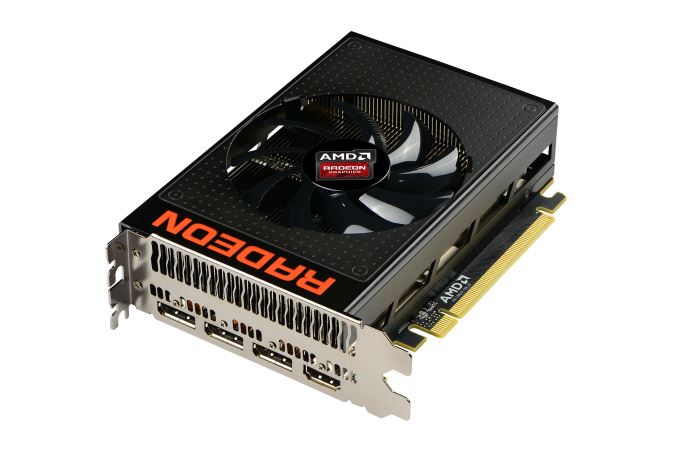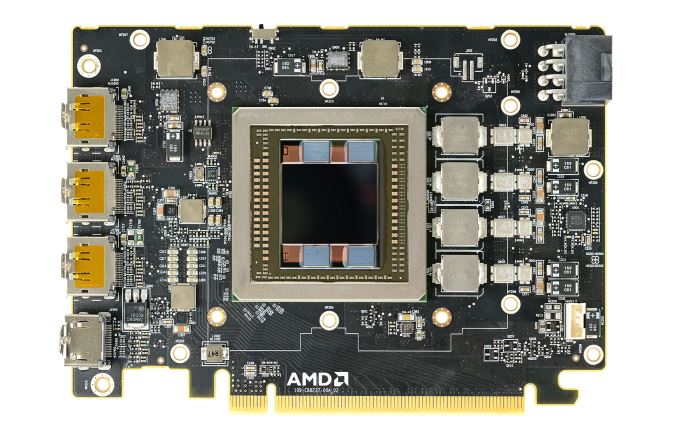The AMD Radeon R9 Nano Review: The Power of Size
by Ryan Smith on September 10, 2015 8:00 AM ESTFinal Words
Of all of the Fiji-based cards we’ve looked at so far, I feel like the Radeon R9 Nano is the most interesting of them. It’s not the fastest card or the cheapest card, but I like that AMD is trying unconventional things. A product like the R9 Nano will never be a high volume product, but it’s the kind of outside the box thinking AMD needs to do in order to better differentiate themselves from NVIDIA and to escape their increasingly damaging reputation as the value alternative underdog.
To that end there’s a lot to like about the R9 Nano, though it admittedly defies standard categorization at times. By all practical metrics this is a luxury card in the same vein as NVIDIA’s GTX Titan series, but at the same time it’s not a card built for chart-topping performance. Rather it’s a card built to push the envelope on power and space efficiency. This makes AMD’s job to sell the card to the public both harder and easier, though not always for obvious reasons.
Starting with the highlights then, let’s talk about the size. As far as Mini-ITX cards go the R9 Nano is a card without an equal. It is the fastest Mini-ITX card on the market and comfortably so, thanks to the fact that all other cards in this space are based on lower performing parts such as the GeForce GTX 970 and Radeon R9 380. Producing a small card is a solid, practical application of the Fiji package and the space savings of HBM, allowing AMD to produce a card just 6 inches (152mm) long. If you need the fastest thing that fits into 170mm or less – and you don’t mind paying top dollar for it – then the R9 Nano has earned its place right there.
Meanwhile when it comes to energy efficiency, the R9 Nano also marks a new high point for AMD. To cut right to the chase, AMD has struggled on the subject of energy efficiency for some time now, particularly since NVIDIA launched their Maxwell 1 and Maxwell 2 architectures last year. The release of the R9 Nano represents a significant improvement for AMD, showing us what an energy efficient implementation of Fiji is capable of.
Relative to the other Fiji cards – the Radeon R9 Fury series – AMD has been able to significantly cut their power consumption in exchange for a limited performance regression. At 2560x1440 – what I expect will be the gaming sweet spot for the R9 Nano – the card delivers 90% of the R9 Fury X’s performance and 96% of the R9 Fury’s performance. Though a tangible decrease in performance, it comes with 35% and 20% decrease in power consumption respectively, allowing AMD to offer better performance-per-watt than any other Radeon product to date.
Now there is a catch here, and that these efficiency improvements come from chip binning and a careful crafting of the product specifications, and not from an architectural improvement. On the whole Fiji still needs to draw quite a bit of power to achieve its peak performance and R9 Nano doesn’t change this. Instead with R9 Nano AMD makes a deliberate and smart trade-off to back off on GPU clockspeeds to save significant amounts of power. The last 100MHz of any chip is going to be the most expensive from a power standpoint, and as we’ve seen this is clearly the case for Fiji as well.
Otherwise on a broader competitive basis, while AMD is enjoying an improvement in energy efficiency they still must contend with NVIDIA, and here is where things get murky. Relative to the rest of their lineup the R9 Nano’s energy efficiency is fantastic. However relative to the energy efficiency of NVIDIA’s lineup, AMD’s gains mostly serve to close the gap that already existed. While admittedly only painting the broadest of strokes here, R9 Nano demonstrates slightly better performance than GTX 980 –around 5% at 2560x1440 – for a similar increase in power consumption. Which is to say that AMD has closed the gap, but they don’t have any real lead.
As a result the answer to the question “is there a market for energy efficient cards within the desktop space?” is going to hinge on price, and that puts AMD in a rough spot given the R9 Nano’s status as a luxury card. Clearly there’s a market for such cards – NVIDIA has spent the last year doing just that – but price is clearly a factor as well. Luxury products typically offer something that no other product offers, and while AMD’s energy efficiency has improved here, they aren’t offering a level of efficiency NVIDIA wasn’t already offering. And that as a result makes AMD’s task all the harder; they can’t pitch energy efficiency as a luxury element if NVIDIA already offers it.
In the end then the R9 Nano is a mixed bag for potential buyers. Its $650 price tag is without a doubt steep compared to the R9 Fury X and GTX 980 Ti, but in its niche of Mini-ITX cards it’s the card to beat, and that will give AMD the room they need to charge that price. On the other hand as great as R9 Nano’s power consumption and energy efficiency are, unless you also need the small size it doesn’t do enough to set itself apart from cheaper products like the GTX 980.
Finally, turning our eyes towards the future, there is one final Fiji product launch on AMD’s 2015 roadmap, and that is the unnamed dual Fiji card. By launching the R9 Nano first, AMD has primed the pump to potentially take their dual-GPU card in one of two different directions. They could essentially combine a pair of R9 Fury Xs and go for a maximum power, maximum performance card similar to the Radeon R9 295X2. On the other hand if they were to combine a pair of R9 Nanos they could produce a slightly slower but much more power efficient card. Both configurations have their virtues and weaknesses – energy efficiency versus absolute performance – so it should be interesting to see which of these two routes AMD takes later this year.












284 Comments
View All Comments
Will Robinson - Thursday, September 10, 2015 - link
Yup,I agree.Dammed with faint praise is the best you'll see for AMD cards there.
Their comments section is an NV fanboy fest led by Chuckula/Chizow and approved by TR.
silverblue - Friday, September 11, 2015 - link
Semiaccurate would've most likely gone the same way had Charlie not locked it all down to subscribers. The only downside is the lack of a daily drashek fix.I think wccftech is another of chizow's haunts, but don't quote me on that.
Gasaraki88 - Friday, September 11, 2015 - link
Oh come on. AMD didn't give a card to Kyle from HardOCP also. So you're saying all the review sites out there are bias against AMD?jardows2 - Friday, September 11, 2015 - link
After reading several recent H's reviews of AMD products, where their testing shows the AMD card slightly slower than the nVidia product, then the conclusion stating the AMD product is a piece of trash and not worth anyone's money, without any of their own testing data backing up such a harsh conclusion, I don't blame AMD for not sending them a card.Alexvrb - Friday, September 11, 2015 - link
Yeah I kind of saw that one coming. I still read H sometimes, but you really have to draw your own conclusions and keep the salt handy. With TR, it's not only what they report, it's what they refuse to report. It's far from the worse, but there's a pattern.AT is my favorite overall, anyway.
InquisitorDavid - Saturday, September 12, 2015 - link
I don't know what your level of 'recent' is, but the R9 380 and R9 390x both got decent reviews. The 390x got a silver award, basically being touted as a cheaper, more power-hungry 980 with more VRAM (truth), and the R9 380 was given a Gold award because it performed better than a 960 at the same price range.The Fury got no awards for being on-par with the stock 980, while costing more. They saw the 390x having better value (thus the silver award), despite the increased power draw.
If anything, AMD has been getting a lot of crap because they've been losing for a while now. Less efficiency, rebrands, and all. OC'ing the 390x gets it to the same level as a 980 reference, and will consume about 200w more. It's cheaper, however, and we all know that's what AMD has been doing for a while now - value for money. It's the only battlefield they can claim any sort of real victory on. With the Fury and Nano, that gets completely thrown out the window.
The Fury X was hamstrung by the release of the 980ti (which was clearly a blocking maneuver by NV). Without the 980ti, it would've been the king of value. The "overclocker's dream" statement was still a bald-faced lie.
althaz - Monday, September 14, 2015 - link
If prices are equal and the AMD card is slightly slower, then the AMD card *IS* worthless. Who would pay the same money to get slightly worse performance and use more power? Only idiots.althaz - Monday, September 14, 2015 - link
Anybody that hasn't been pro-nVidia for the past few years has been doing it wrong. AMD have been using more power to offer less performance (at similar prices) - they have been behind for *ages* now. They still are, but at least it looks like HBM will bring the performance needed (next generation probably, it's obviously not there yet).anubis44 - Thursday, October 8, 2015 - link
I like TechReport, and find their coverage of tech very detailed, but yes, I have to agree with you that they've essentially been portraying AMD as just not quite as good as nVidia, yet all the while minimizing or ignoring the Green Goblin's dubious business practices ($200 G-Sync tax) and misrepresentation of their products (the 3.5GB GTX970 that somehow didn't completely torpedo that card's recommendation).Frenetic Pony - Thursday, September 10, 2015 - link
I've looked at Tech Report, fuck Tech Report. None of their tests seem to reflect anyone elses, I tried a few of the graphs and they're literally a statistical outlier (at least for my quick tests).